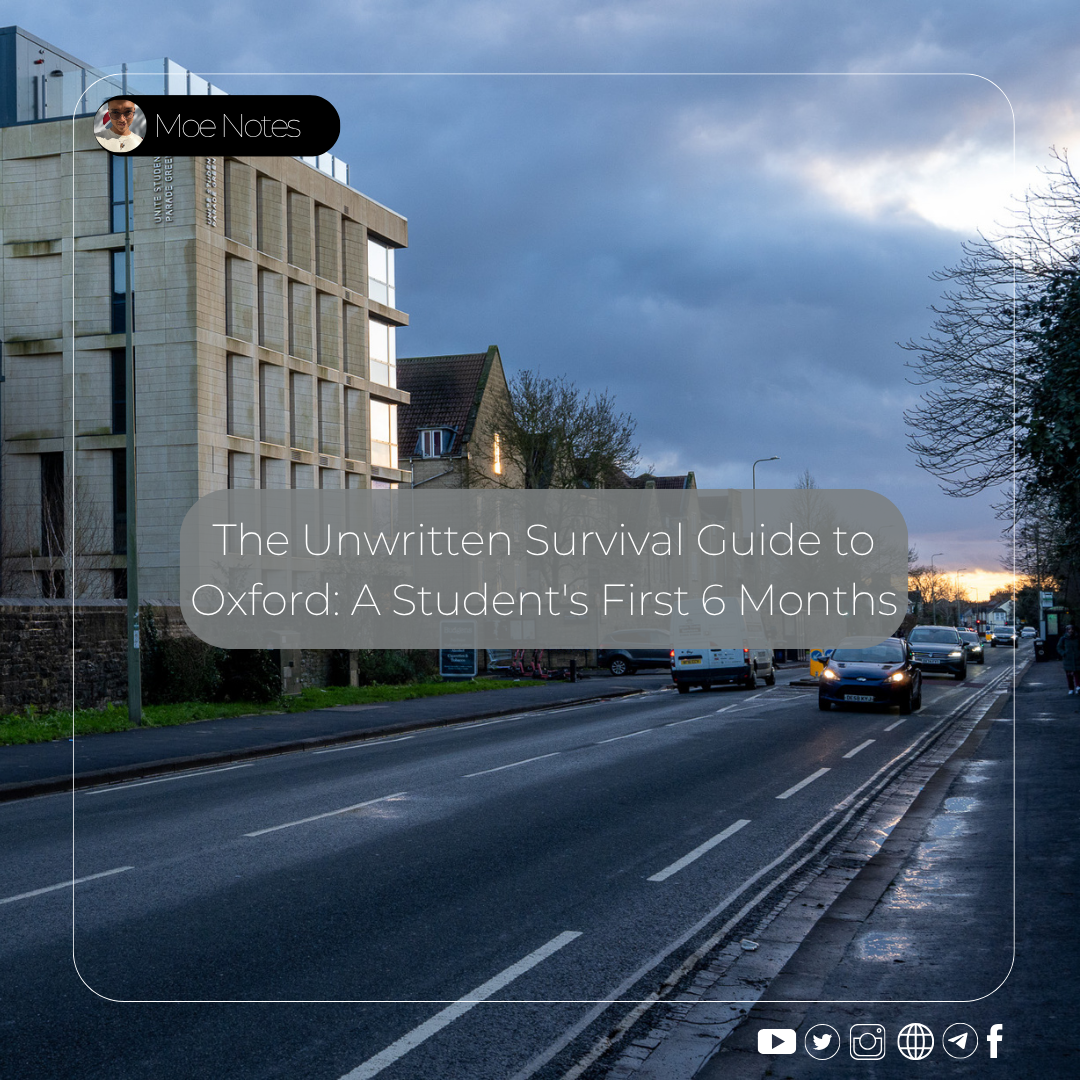The Unwritten Survival Guide to Oxford: A Student’s First 6 Months

(Read Time: 11 Minutes)
This article is also available in [Burmese].
The first time you see a photo of Oxford, you see the dreaming spires and ancient colleges. The last thing on your mind is the price of a loaf of bread at a Tesco Express. But after six months as an architecture student at Oxford Brookes University, your success here will be defined as much by your mastery of grocery budgets as by your academic essays.
The university prospectus sells you a dream. This guide is different. It’s a data-driven blueprint for navigating reality. I’ve fact-checked the costs and systems as of mid-2025, as the landscape is constantly changing, especially with the UK’s ongoing cost-of-living crisis. This is the unvarnished truth I wish someone had given me when I first arrived from Myanmar.
1. The Great Accommodation Puzzle: Your Most Important Financial Decision
Your accommodation isn’t just a room; it’s your sanctuary, your financial baseline, and the anchor for your entire life. My first-year choice in a university hall cost me around £190/week. It was a safe bet, but I didn’t fully grasp the hidden costs of a “less-than-ideal” location.
For the 2025/2026 academic year, you can expect to navigate a few key tiers of student living. The most basic option, the Essential Tier, costs between £165 and £185 per week. For this price, you’ll get a single bed in a smaller room and share a bathroom with 5 to 8 other students. These are often in older halls or those further from campus. While it seems like a saving, a 45-minute walk to a 9 AM lecture will likely push you to buy a £20 weekly bus pass, eroding that saving entirely.
The most popular choice is the Standard Tier, which costs between £190 and £225 per week. This typically gets you the crucial upgrade to an en-suite (a private toilet and shower), while still sharing a kitchen. Newer, well-located halls fall into this category, offering a good balance of privacy, convenience, and Cost.
Moving up to the Premium Tier (£230 - £280+) provides you with more comfort, including a larger room, a double bed, and often access to better facilities such as an on-site gym, professional staff, and dedicated study areas. These are usually modern, privately-managed halls from providers like iQ Student Accommodation or CRM Students, offering a more hotel-like experience. Finally, for those who crave complete independence, the Studio Tier (£300 - £450+) provides a self-contained space with your kitchenette. It offers total privacy but at a cost that is double the Essential tier—a staggering difference of over £6,000 for a full academic year—and it can be incredibly isolating.
What about renting a room in a private house?
For a new international student, this path is challenging, and I recommend against it for your first year. UK landlords require tenants to have a “UK-based guarantor”—someone in the UK who owns property and agrees to pay your rent if you fail to. As a new student, you will not have one. The alternative is often paying 6 to 12 months of rent upfront, a massive financial risk. Furthermore, trying to secure a room from abroad without viewing it in person is a prime target for rental scams. Stick to official university or reputable private provider halls for your first year. It’s a built-in safety net.
2. The Mobility Matrix: Decoding Oxford Transport
Getting around Oxford is a strategic game. Every choice is a trade-off between Cost, time, and convenience.
- Walking
- Cost: £0.
- Pros: Reliable, healthy, lets you discover the city’s hidden alleys.
- Cons: Slow. In the UK’s cold, damp winter, a 30-minute walk can feel like an expedition.
- The Reality: Your default for short distances, but impractical as your sole means of transport if you live far from campus.
Bus
- Cost: A single trip is around £2.50. A 1-week student pass, available via the Oxford Bus Company or Stagecoach apps, is a much better value, typically priced at around £15-£20.
- Pros: Protects you from the weather; extensive network covers the whole city.
- Cons: Subject to traffic; can get crowded; service frequency drops in the late evening.
- The Reality: Essential for anyone living more than a 25-minute walk from campus. Download both the Stagecoach and Oxford Bus Company apps to compare live times.
Bicycle
- Cost: £300+ for a decent new bike from a store like Halfords or a local shop, plus £50-£80 for a high-quality D-Lock (essential!), helmet, and lights.
- Pros: The perfect balance of speed, freedom, and low running costs.
- Cons: High initial investment; risk of theft; maintenance (punctures); requires effort in the rain.
- The Reality: The undisputed king of student transport in Oxford, if you can afford the setup. It turns a 30-minute walk into a 10-minute ride.
E-Scooter Rental
- Fact-Check & Correction: The current operator for the city’s trial is Voi. To use one, you must have at least a Provisional Driving Licence, which you can apply for online from the DVLA for £34 (it is not a “teaching license”).
- Cost: An unlocking fee (e.g., £1) plus ~20p per minute.
- Pros: Fast and fun for spontaneous short journeys.
- Cons: Expensive for regular use; geofenced (they won’t work outside designated zones); can be hard to find an available one during peak times.
- The Reality: A novelty or an emergency option, not a viable daily commuting strategy.
Car
- The Reality: Do not bring a car to Oxford as a student. This is a financial trap. The city’s Zero Emission Zone (ZEZ) and notoriously difficult parking make it a nightmare to navigate. Insurance for a young driver can be over £2,000 per year. You will spend a fortune on a vehicle you cannot use.
3. The Food Equation: Your £70 Weekly Challenge
My weekly grocery budget now hovers around £70, which is a realistic figure for a single person who cooks most meals and wants a mix of Western and Asian ingredients. Your strategy must be multi-layered.
The Supermarket Hierarchy:
Your base of operations should be the budget kings, Aldi, and Lidl. This is where you’ll buy your staples: chicken, bread, milk, pasta, and common vegetables. Then, you visit the mainstream stores like Tesco or Sainsbury’s for specific branded items or a wider variety, always using their loyalty cards (Clubcard and Nectar) to access the essential member-only pricing. The small convenience stores (Tesco Express, Co-op) are for emergencies only, as their prices carry a significant “convenience tax.”
The Hunt for a Taste of Home: The Asian Supermarket Reality
Inevitably, you will crave the specific flavors of home that a Tesco cannot provide. In Oxford, you’ll find local Oriental markets, and in larger cities (or for online delivery), you’ll find major suppliers like Wing Yip or H Mart. Here you can see the essentials:
- A large 10kg bag of Jasmine rice will cost around £20-£25, but it will last you for months.
- A bottle of good-quality Lee Kum Kee soy sauce will cost £ 3- £ 4.
- Bok choy, pak choi, or other greens will be more expensive than local cabbage, perhaps £2-£3 for a small bunch.
- Specialty items, such as chili oil, fermented bean paste, and specific noodle types, are all available.
Now, I have to be honest. While these stores are a lifeline, they are also often a source of quiet disappointment for me. Many of the vegetables are frozen or have been air-freighted across the world; they lack the vibrant freshness and depth of flavour you find in a market in Yangon. The sauces and condiments are lifesavers, but finding truly fresh, high-quality produce that tastes like home is a constant challenge. It’s a necessary compromise, not a perfect solution.
Master the “Yellow Sticker” System:
This is the ultimate student hack. Supermarkets heavily discount items that are near their sell-by date. This usually happens in the evening (typically 6-8 PM). You can get delicious bread, meat, and ready meals for 50-90% off the original price. Learning the “yellow sticker” times at your local Tesco or Sainsbury’s can cut your food bill by a quarter.
The Meal-Kit Experiment (Gousto, HelloFresh, Green Chef):
- Pros: They eliminate food waste by providing exact portions and teach you to cook a variety of new dishes. The introductory discount offers are fantastic value.
- Cons: At full price, they are more expensive than shopping for yourself. They generate significant packaging waste. You have less flexibility than just deciding what you want to eat on the day.
- The Reality: Use them for a few weeks with a discount code to build a portfolio of 5-10 recipes you love, then cancel your subscription and learn to cook those recipes with ingredients from Aldi.
4. The ‘Hidden’ Costs: Budgeting Beyond the Basics
Your rent, transport, and food are the big three, but the small, recurring “life admin” costs can quickly deplete your account if you’re not prepared. This is the budget category that many new students often overlook.
Academic Essentials
This varies hugely by course. For a humanities student, it might be minimal. For me, as an architecture student, it’s a significant expense.
- Books: Do not buy every book on your reading list brand new. It’s a trap. Use the university library first. For core textbooks you must own, look for second-hand copies on Amazon Marketplace or World of Books. Realistic Cost: £50 - £200 per year.
- Printing & Specialist Supplies: My biggest shock. High-quality A1 printing for presentations, foam board for model making, specialized pens, and sketchbooks are costly. The university print shop is convenient, but it is also expensive. RealistCostost (for a design student): £300 - £600 per year. Budget for this from day one.
Living & Subscriptions
- Mobile Phone Plan: Avoid signing a long-term contract when you first arrive. Start with a Pay-As-You-Go SIM from a provider like giffgaff or SMARTY. Once you have a UK bank account, you can switch to a SIM-only monthly plan for around £10-£15/month for a generous amount of data.
- Health & Prescriptions: As an international student who has paid the Immigration Health Surcharge (IHS), you can access the National Health Service (NHS). A visit to a doctor (GP) is free. However, any medication they prescribe is not. In England, an NHS prescription costs £9.65 per item. This can add up.
- Gym Membership: The university gym is usually the best value, typically costing around £150-£250 for the entire year. Private budget gyms, such as PureGym or The Gym Group, offer flexible monthly memberships for £25-£35/month.
Social Life & Clothing
This is the most variable part of your budget, and the easiest place to overspend.
- Eating/Drinking Out: Oxford is an expensive city. A pint of beer in a central pub can cost £6.50 - £7.50. A casual meal out will be £20+. Limiting this to once a week is a realistic budgeting goal.
- Clothing: You will likely need to buy clothes suitable for the UK climate, especially a proper waterproof and windproof coat. Avoid fast-fashion brands. For quality basics that last, look for sales at stores like Uniqlo. For affordable winter gear, Mountain Warehouse or Decathlon are excellent options. Realistic Setup Cost: £100 - £200 for a good coat, jumper, and waterproof shoes.
Conclusion: The Real Final Exam
Studying in Oxford is a privilege, but the experience is not effortless. Your final grade will be written on a university certificate, but your real final exam is a silent one.It’ss the moment you can confidently walk into a supermarket and build a week of healthy meals for under £70. It’s knowing which bus to catch without needing to check the app. It’s about creating a budget that works, establishing a routine that supports your mental health, and living a life that is truly your own.
That journey of building a life from zero is daunting. It is also the most profound and empowering education you will ever receive. This blueprint helps you start on solid ground.



